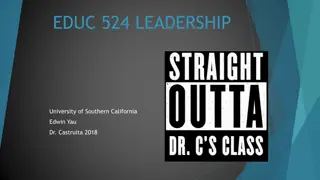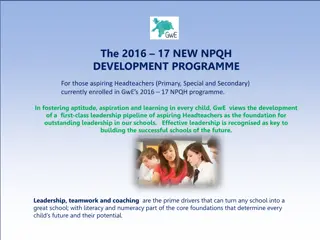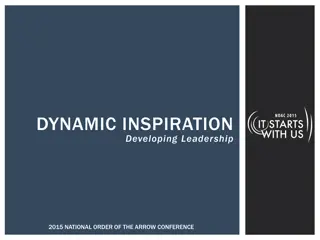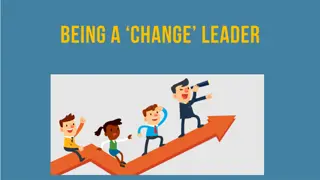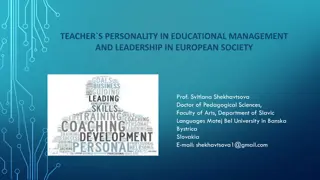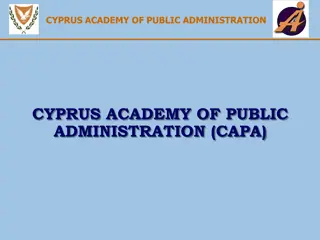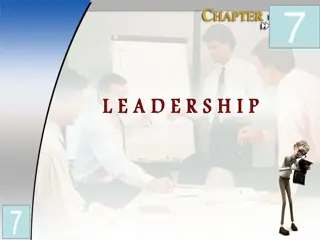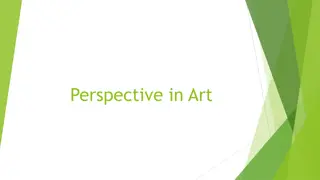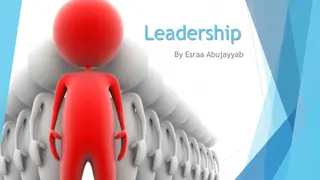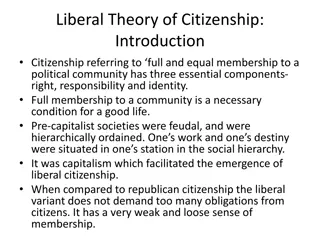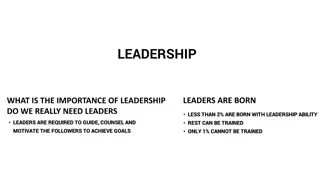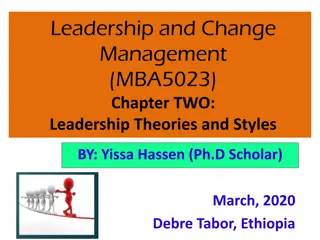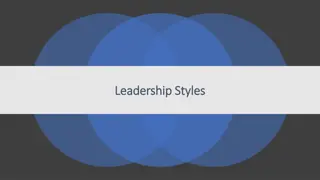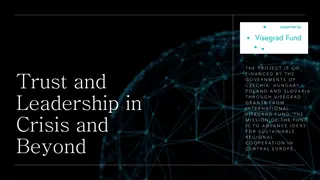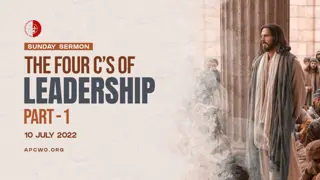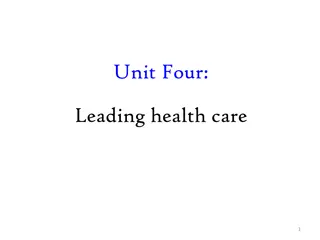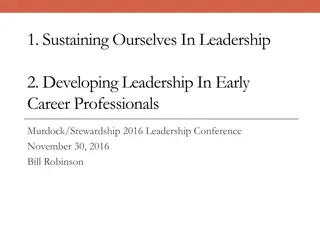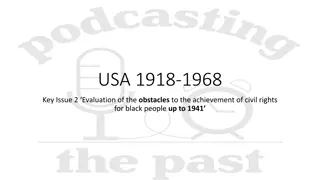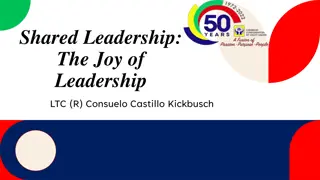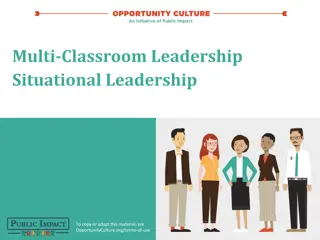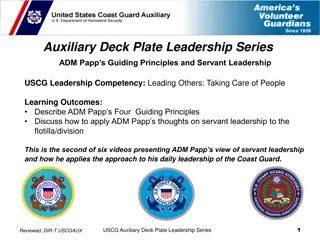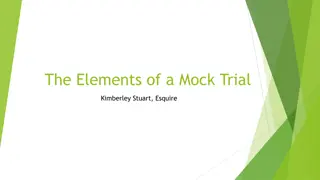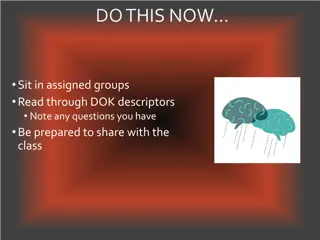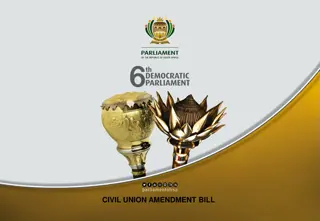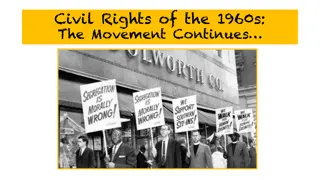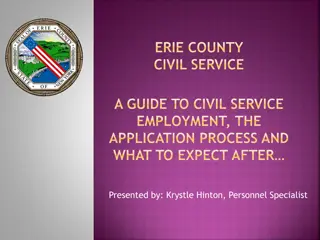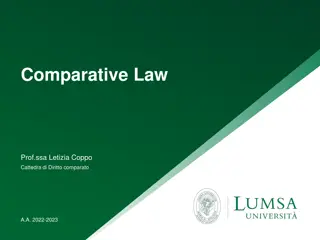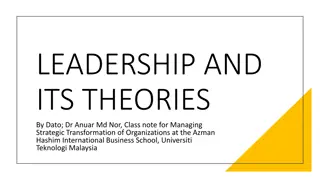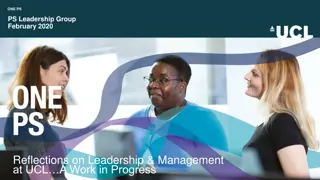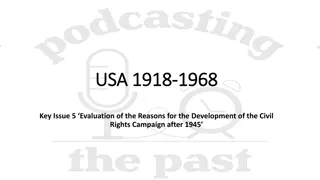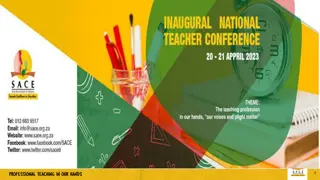Evolution of Leadership and Management in the Civil Service: A Historical Perspective
The evolution of leadership and management within the Civil Service is traced from the establishment of the Civil Service College in 1970 to the recent initiatives like the Government Skills and Curriculum Unit established in 2020. The journey includes significant milestones such as the introduction of the Civil Service Code in 2010, the creation of the National School of Government in 2005, and the launch of the Civil Service Leadership Academy in 2017. Various competency frameworks and development schemes have contributed to shaping effective leadership within the Civil Service over the decades.
Download Presentation

Please find below an Image/Link to download the presentation.
The content on the website is provided AS IS for your information and personal use only. It may not be sold, licensed, or shared on other websites without obtaining consent from the author. Download presentation by click this link. If you encounter any issues during the download, it is possible that the publisher has removed the file from their server.
E N D
Presentation Transcript
Leading to Deliver: a leadership and management prospectus History and evidence pack June 2022 This slide pack was amended to remove internal data and management information that were used for internal discussions and planning.
Leadership and Management History 1970-1989 1990-1999 2000-2009 2010-2014 2015-2019 2020-present Fulton Committee (1) recommendations from 1968 were accepted by the newly formed Civil Service Department who set up the Civil Service College (CSC) in three sites in Central London, Edinburgh and Sunningdale. The CSC was opened on 26 June 1970 (2). The Seven Principles of public life were introduced in 1995 - the seventh principle is leadership (4, 5). An SCS competency framework was developed in 2000 supported by 360 degree feedback to inform personal development plans (9). The High Potential Development Scheme was launched in 2004 for Directors. The National School of Government was formed in 2005 to replace CMPS. Largely based at Sunningdale Park and reliant on income from course fees. Staffed by academics, trainers and civil servants, but also using SCS experts to deliver (10,11). In 2008, a competency framework for all civil servants was introduced (9) and the central Policy Profession Unit (PPU) and Operational Delivery Profession (ODP) teams established. PPU began a leaders teaching leaders approach circa 2009. The Civil Service Code was launched in 2010 (12, 13). The Leadership Statement was established in 2015 (16), and a project leadership programme with Cranfield University put in place. PPU also launched it s Executive Masters in Public Policy with LSE. In 2016, A Brilliant Civil Service focused on effective leaders and a workforce plan which committed to developing world class leadership (17). Leadership in Action set out what good leadership looked like in the Civil Service (18). The National School of Government closed in 2012 and Civil Service Learning was created (3). The Chancellor of the Duchy of Lancaster s Ditchley speech was delivered in 2020 (19) and set out challenges for a Modern 21st Century Civil Service, leading to the launch of the Declaration on Government Reform (DGR) in 2021 (20). In 2020, the Government Skills and Curriculum Unit was established as part of the DGR commitments. The SCS (Senior Civil Servants) were created in 1996 consisting of circa 3,800 specialist and generalist managers (6). The Civil Service Reform Plan in 2012 established the functional/professions model and set out to improve skills and a capability plan for strengthening leadership and talent management (14). In the same year, SCS indicators of potential were developed (reviewed in 2018) and a revised competency framework launched (15). The Centre for Management and Policy Studies (CMPS) in the Cabinet Office was announced in 1999 as part of the Modernising Government White Paper (7, 8). In 1989, the CSC business model moved to hard charging which saw CSC compete with the external market with income reliant on Departments purchasing CSC training provision. This led to CSC focusing on the delivery of mass training (3). In 2017, the Civil Service Leadership Academy (CSLA) was established and the META programme for ethnic minority participants was integrated into FLS. In 2019, DELTA (FLS participants with a disability or long-term health condition) began. The National Leadership Centre launched in 2019 (3). CSC was absorbed into CMPS to improve management, leadership and policy capability (3). In 2021, the Service Delivery Academy launched its OpDel Excel programme for Directors aspiring to be ODP Directors General. G6/SCS1 applications for the Government Property Leadership Programme are invited. In 2013, the G6/7 Future Leaders Scheme (FLS) and the Individual Development Programme (IDP) for Directors General were introduced. 2
Our foundations are solid What has the programme provided?...Useful to connect with peers across Government; Community, friendship and insight. (Deputy Director, 2019) Brilliant facilitation, thought-provoking discussion grounded in theory and space to explore thoughts and discuss ideas. (FLS participant, 2019) This was a fantastic module, very engaging. The tutors are excellent, knowledgeable and engaging. The balance of group sessions and learning was managed well and effectively. (G7 participant, 2019) The tutors were really great on this module, energised, positive, supportive and knowledgeable. The relevance of this module and all the theory to our own circumstances and practices was perfectly pitched. (FLS participant, 2019) I have explored the models further... I then intend to roll this out to my SLT. (CSLA participant, 2020) ...but there is more we can do to assure impact, and raise the floor and the ceiling of skills, knowledge and networks for our leaders and managers 3
Overview of Problem Statements 1 An incoherent offer Multiple routes and interventions available, without any clear links to supply and demand requirements. 2 No clear organisational requirements or common purpose across all interventions No central outline of desirable, prescribed or mandated offer, which balances individual and corporate needs. 3 Stakeholder needs not met Gaps in the curriculum (particularly people management at senior levels) and quality is inconsistent. 4 Weak offer in training for new skills Big data analysis, physical sciences, hybrid working and the future of work. 5 Unconnected leaders We are not routinely building a leadership community which has porosity across the public/private sectors. 6 A continuous learning organisation culture does not yet exist A genuine commitment to learning and development is not yet in place across the organisation. 7 Unknown spend and/or a lack of robust data to determine organisational impact It is difficult to be precise or predict how much money is being spent across the system. 4
Problem Statement 1: An incoherent offer Our current offer is perceived to be complicated and hard-to-navigate, having evolved over the last two decades. There are multiple owners, platforms and overlapping content distributed between CSL, central and departmental/professional programmes, as well as a mix of selective and non-selective content, targeted at many different levels. EVIDENCE: TOO MUCH CHOICE AND DUPLICATION, WITH LEARNING NOT NECESSARILY CONNECTED Several departments have their own leadership and management development programmes. Examples include: FCDO s Fundamentals of Line Management, DWP s Leadership Foundations, HMRC s Management Development Programme, and DIT s management standards. There are 84 different leadership and management courses on the CS Learning Platform, with multiple routes to access them (profession, departmental, selective, non-selective). Internal Government Shared Services data shows that there are dozens of leadership and management online courses available which were not completed by a single user over the last three years. Course was fine overall and some good parts but also a fair amount of fluff. Good if you haven t done much on leadership recently but nothing massively new if you have done other recent leadership courses such as the Senior Leadership Scheme. (Deputy Director) There is no relationship across the selective accelerated development programmes, and outcomes are not aligned. 5
Problem Statement 1: An incoherent offer Our current offer is perceived to be complicated and hard-to-navigate, having evolved iteratively over the last two decades. There are multiple owners, platforms and overlapping content distributed between CSL, central and departmental/professional programmes, as well as a mix of selective and non-selective content, targeted at many different levels. STAKEHOLDER FEEDBACK I would recommend joining to increase network but probably felt it wasn't heavy enough in the 'what does being a Director in the CS looks or feels like' (SCS2) There just seems to be so many places to go. As a learning and development professional it can be quite hard and time consuming, exhausting to do it basically, there s too many frameworks, all over the place. SCS participants want more consistent learning and development opportunities and clearer standards for learning set from the centre. Figure 1: Civil Service People Survey 2020 (CSPS 2020) 6
Problem Statement 2: No clear organisational requirements or common purpose across all interventions There is no clear, centrally prescribed or mandated offer mapped against strategic priorities. Multiple models of leadership and management co-exist across the system. EVIDENCE: THERE IS A LACK OF CLARITY ON LEADERSHIP AND MANAGEMENT LEARNING EXPECTATIONS We do not have a clear, centrally planned and mandated leadership and management offer for all. The importance of matching leadership development effectively to organisational need is highlighted in the academic literature. Clear definitions about what good leadership and management looks like in a specific context is important for both high quality learning interventions and for effective evaluation and valid assessment of capability (22) (23). Satisfaction rates were generally high for National Leadership Centre (NLC) programmes (93%) but where expectations were not fully met delegates reported this was due to unclear objectives at the outset (21). 7
Problem Statement 2: No clear organisational requirements or common purpose across all interventions There is no clear, centrally prescribed or mandated offer mapped against strategic priorities. Multiple models of leadership and management co-exist across the system. STAKEHOLDER FEEDBACK Many comparisons were made about the High Potential Development Scheme (HPDS) and Major Projects Leadership Academy (MPLA). People value the structure and substantive content of MPLA, the strong, continuous, presence of a Programme Director in every session, joining the dots and maintaining a clear purpose. They prize knowing what they are going to be learning in advance, having a curriculum to follow. They value the prestige that comes from being assessed and 'passing'. HPDS has lost its way too many people on it, too unstructured, no guiding mind, insufficient links to reform yet a passport to DG it appears. (Director, 2020) The programme needs less introspection - this could be a generic 'growth' offer for any sector, and as such is superficial. Would be good to have more idea of what the Civil Service wants and needs from us as leaders. (Director, 2020) Each Top 200 event feels like an island no connection to last one, no follow-up on actions. (Director General, 2020) 8
Problem Statement 3: Stakeholder needs not met Our current Leadership & Management development offer is not yet able to fully meet the strategic workforce development needs of the system. Stakeholders, including Ministers, oversight bodies and experts have publicly expressed mixed confidence in, and satisfaction with, our current offer and have an expectation of change. EVIDENCE: CURRENT SATISFACTION RATES ARE MOSTLY POSITIVE AND PARTICIPANTS VALUE THE OPPORTUNITY TO MEET THEIR PEERS, BUT ATTENDANCE DROP OFF IS HIGH IN LONGER PROGRAMMES 96% of National Leadership Centre (NLC) programme participants expectations were fully met, although module 2 received a 34% satisfaction rate. (21) Internal information shows the Civil Service Leadership Academy had a decline in attendance through programme lifecycles. In 2018, DIT worked with supplier partner Harthill s to design and develop the DIT Global Directors Leadership Programme. This was in the absence of anything thought to be appropriate or available through CSLA or CSL. Internal information showed a dip in satisfaction, partly due a shift to virtual delivery. (HR Deputy Director, DIT) 9
Problem Statement 3: Stakeholder needs not met Our current Leadership & Management development offer is not yet able to fully meet the strategic workforce development needs of the system. Stakeholders, including Ministers, oversight bodies and experts have publicly expressed mixed confidence in, and satisfaction with, our current offer and have an expectation of change. EVIDENCE: OUR MODEL AND APPROACH TO SELECTIVE DEVELOPMENT HAS HAS NOT SIGNIFICANTLY CHANGED, DESPITE EXPECTATIONS, NEEDS AND DEMOGRAPHICS CHANGING OVER THE LAST FEW YEARS I was a bit disappointed overall in the two day programme, I felt it lacked direction and structure and had very little unique content. The first session on the second day was essentially the same as the last session on the first day. Creeping death does not work - it ends up eliciting views just for the sake of saying something. The main advantage of the programme was meeting other people and chatting about this and that, and comparing experiences. But it would have been nice to have some meaty news things to think about. (CSLA participant) In comparison to the Civil Service Accelerated Development Programmes, the duration of selective programmes in many other organisations is on average 12 months not two years: Johnsons Apparelmaster (winner - 2018 Talent Management Awards); BBC s Senior Leadership Development Programme; Applus+ Global Management Development Programme (9 months) (Personnel Today Awards 2020 shortlist). Each year the G6/7 Future Leaders Scheme (FLS) and SCS1 Senior Leaders Scheme (SLS) are heavily oversubscribed. It was disappointing that, whilst the scheme is described as a developmental option, the feedback suggests you are actually only selecting people who already have the required skills. (FLS Candidate 2020) 10
Problem Statement 3: Stakeholder needs not met Our current Leadership & Management development offer is not yet able to fully meet the strategic workforce development needs of the system. Stakeholders, including Ministers, oversight bodies and experts have publicly expressed mixed confidence in, and satisfaction with, our current offer and have an expectation of change. EVIDENCE: INCREASED AND NEW DEMANDS WILL REQUIRE A DIFFERENT CENTRAL DELIVERY MODEL TO ENSURE EVERY LEADER AND MANAGER HAS ACCESS TO THE RIGHT KNOWLEDGE AND SKILLS Increasing numbers of people are juggling multiple careers, with breaks and transitions, which means how we assess and manage talent in the future will need to adapt. (The 100-Year Life: Living and Working in an Age of Longevity). (24) Annually, and on average, CSLA provides training to around 4% of the SCS1 and SCS2 population through its two core leadership programmes, the Director Leadership Programme (DLP) and the Deputy Director Leadership Programme (DDLP). These interventions are designed as transition programmes for those SCS new to grade, but we know anecdotally that participants have often been in role for some time before attending. Supply for selective programmes is not informed by workforce demand. 11
Problem Statement 3: Stakeholder needs not met Our current Leadership & Management development offer is not yet able to fully meet the strategic workforce development needs of the system. Stakeholders, including Ministers, oversight bodies and experts have publicly expressed mixed confidence in, and satisfaction with, our current offer and have an expectation of change. STAKEHOLDER FEEDBACK SCS report they wanted more support in their career development and progression, as well as a better induction. Almost half of respondents to the Civil Service People Survey 2020 are either neutral or unfavourable when asked whether learning and development opportunities they have completed are helping them to develop their career. Almost a half of respondents below SCS (45%) responded negatively or remained neutral when asked if the L&D they had completed in the last 12 months had improved their performance. (25) Figure 3: Civil Service People Survey 2020 (CSPS 2020) 12
Problem Statement 4: Weak offer in training for new skills We need to develop leaders and managers for forward-looking skills, and a recognition there are some gaps in current curriculum content. EVIDENCE: REVISION OF THE CURRICULUM IS NEEDED TO ENSURE IT IS MORE RELEVANT AND FUTURE PROOF Public sector leaders self report financial acumen as their weakest competency, whilst collaboration, engaging and inspiring and instilling trust were areas participants felt was overall their strongest competencies. There should be a cadre of retired and current Senior Civil Servants trained for crisis management who can be brought in to head up a crisis team as senior leaders. (28) Senior leaders need to take a longer-term perspective, to understand current system performance, and seek to continually improve processes and services. Transformation requires Civil Service leaders who understand the skills required to transform ... (26) developing expertise in areas including digital, data, science, project and commercial delivery . we will ensure Ministers .. work effectively with civil servants. We will set a new standard for diversity and inclusion. (20) The Director s Leadership Programme pre-needs analysis found a large majority considered content on leading in the digital age as vital or very important. 13
Problem Statement 5: Unconnected leaders We are not using the convening power we have fully, to create network effect, knowledge spillover, and potent cohorts. There is growing evidence of material positive impact of greater inter- and intra- organisational permeability , but we have an incomplete picture of how networked our leaders are, the impact of networks in the Civil Service and Public Sector. EVIDENCE: WE ARE MISSING OPPORTUNITIES TO JOIN UP ALL LEADERS ACROSS THE CIVIL SERVICE, OR BOLSTER DIALOGUE WITH OTHER SECTORS, INCREASING COLLABORATION AND BUILDING POROSITY The networking element is fairly strong with the selective, CSLA and NLC programmes, but to effectively network, you have to be one of these schemes. There is no cross-cutting offer to join up leaders and managers across the Civil Service. Networking in leadership development can have positive individual and organisational level outcomes. (28) Leaders are encouraged to spend time in private and third sectors. We will develop an ethos of a connected government across the UK. (20) NLC Year 1 Evaluation (61) reports: - Some connections made through the programme facilitated collaboration on large scale organisational projects. - Participation in the programme had helped to develop a good network of fellow public sector leaders and (95%) said it had helped them to develop a sustainable peer / wider support group. - Programme delegates reported an increase in the proportion of time spent collaborating with people outside of their sector or industry pre and post participation in the programme. 14
Problem Statement 5: Unconnected leaders We are not using the convening power we have fully, to create network effect, knowledge spillover, and potent cohorts. There is growing evidence of material positive impact of greater inter- and intra- organisational permeability , but we have an incomplete picture of how networked our leaders are, the impact of networks in the Civil Service and Public Sector. EVIDENCE STAKEHOLDER FEEDBACK Much of the positive feedback from the CSLA events largely focuses on the value gained from the chance to reflect away from the day job and network with peers, but we are not doing this on scale or maximising the power of the collective. SCS report they want better networking opportunities and ways to share experience and best practice, a greater sense of community and a cross government supportive network. I m afraid I ducked out of the programme after the first session or two, partly because I was offered a place on the WIG leadership scheme with folk from other sectors, and partly I m afraid because I didn t find the first sessions terribly useful or high quality. The sessions covered material I had done before (e.g. on the Senior Leaders Scheme), went on much longer than was needed for the content, and didn t teach me much. At the moment I would not recommend the scheme to other new directors as a good use of their time. I would however recommend the Ashridge-run SLS scheme. (DLP participant, Cohort 1) Yes, it is very worthwhile. You will meet a fantastic and supportive group of colleagues. You will also soon realise that the challenges you are facing are not unique and that you will learn many and various ways to overcome them. You will also have an opportunity to listen to some outstanding SCS who will share their career journey. (CSLA participant) 15
Problem Statement 6: A continuous learning organisation culture does not yet exist We do not encourage or reward a practice of continuous reflection on personal performance, or routinely expect our leaders and managers to pay it forward and train the next generation, as is mandated in other professional services firms. EVIDENCE: A FOCUS ON SELF EVALUATION AND LEARNING WITH OTHERS IS NOT ROUTINELY IN PLACE The most reported barriers to future learning identified by line managers were their team not having time to complete learning and the learning needed not being available when required. A recent (2021) IfG report on CS skills recommends that managers need to be more accountable for developing their teams. They should set rigorous development goals with the people they manage each year and report back on how far they have been met (30). Evidence suggests that leaders can have a strong influence on the learning of their teams. A meta analysis of 36 studies shows that team leadership is strongly and positively related to team learning behaviour. The study also found that leadership style may need to be adapted to task type to create a learning context within the team. A separate meta analysis found that team members outcomes improved by 8% when their leaders were trained. (29) Case studies from the OECD show highly skilled SCS still fall short of their goals due to environmental constraints. We need to ensure that good leaders, once in place, have the autonomy, tools, support, and accountability needed to effectively use their leadership capability. (31) 16
Problem Statement 6: A continuous learning organisation culture does not yet exist We do not encourage or reward a practice of continuous reflection on personal performance, or routinely expect our leaders and managers to pay it forward and train the next generation, as is mandated in other professional services firms. EVIDENCE STAKEHOLDER FEEDBACK DGLP participants have been disappointed at the lack of engagement from other DG cohorts members who have not engaged in the programme. The vast majority of respondents did not feel that the DG Leadership Programme allowed them to examine and apply relevant theoretical and evidence based approaches to enhance their own leadership practice. 17
Problem Statement 7: Unknown spend and/or lack of robust data to determine organisational impact We currently lack robust evidence of what constitutes effective, impactful L&M development across the system. EVIDENCE: OUR DATA ON LEADERSHIP AND MANAGEMENT TRAINING INVESTMENT IS POOR OR NON EXISTENT Outside of the Learning Framework supply chain, we don t have accurate external cost transparency for bespoke, locally procured leadership and management training programmes (e.g. Mindgym, FED). There is no single repository for the Civil Service on Leadership and Management training spend. "I guess what I've seen in other organisations is clear evaluation, people taking responsibility for their own evaluation, and organisation being able to do something about it and report back on the impact things have had." Cost of Cabinet Office provided programmes is well accounted for within CO, but a figure to establish a cross Civil Service spend on leadership and management is not easily accessible. 18
References 1. 2. 3. 4. 5. 6. 7. 8. 9. 10. 11. 12. 13. 14. 15. 16. 17. 18. 19. 20. 21. 22. 23. 24. 25. 26. 27. 28. 29. https://www.civilservant.org.uk/csr-fulton_report-findings.html https://api.parliament.uk/historic-hansard/commons/1968/jun/26/civil-service-fulton-committees-report https://publications.parliament.uk/pa/cm201719/cmselect/cmpubadm/1536/1536.pdf https://www.gov.uk/government/publications/the-7-principles-of-public-life https://www.gov.uk/government/publications/mps-ministers-and-civil-servants-executive-quangos https://www.researchgate.net/publication/242512132_Evaluation_of_Leadership_Development_and_Training_in_the_British_Senior_Civil_Service_the_Search_for_the_Holy_Grail https://www.instituteforgovernment.org.uk/sites/default/files/publications/CMPS%20in%20template%20FINAL.pdf https://api.parliament.uk/historic-hansard/commons/1999/mar/30/modernising-government https://soc.kuleuven.be/io/onderzoek/project/files/hrm27-country-report-uk.pdf https://www.instituteforgovernment.org.uk/sites/default/files/publications/CMPS%20in%20template%20FINAL.pdf https://assets.publishing.service.gov.uk/government/uploads/system/uploads/attachment_data/file/250551/0924.pdf https://www.legislation.gov.uk/ukpga/2010/25/contents https://www.gov.uk/government/publications/civil-service-code https://www.gov.uk/government/publications/civil-service-reform-plan https://www.gov.uk/government/news/level-playing-field-for-all-civil-servants-to-drive-up-performance https://www.gov.uk/government/publications/civil-service-leadership-statement https://civilservice.blog.gov.uk/2016/06/16/our-vision-for-a-brilliant-civil-service-and-what-it-means-for-you/ https://civilservice.blog.gov.uk/2020/04/01/leadership-in-action/ https://www.gov.uk/government/speeches/the-privilege-of-public-service-given-as-the-ditchley-annual-lecture https://www.gov.uk/government/publications/declaration-on-government-reform NLC: The Evaluation of the National Leadership Centre, Ipsos MORI Rosenman ED, Shandro JR, Ilgen JS, Harper AL, Fernandez R. Leadership training in health care action teams: a systematic review. Acad Med. 2014;89(9):1295-130 Hofmann, Riikka, and Vermunt, Jan D. "Professional Learning, Organisational Change and Clinical Leadership Development Outcomes." Medical Education 55.2 (2021): 252-65 Gratton, Lynda & Scott, Andrew J. The 100-Year Life: Living and Working, Bloomsbury, (2020) Civil Service People Survey 2020 NAO Improving operational delivery in government: A good practice guide for senior leaders (March 2021) Boardman Review of Government Procurement in the Covid-19 Pandemic (May 2021) : Rapid Evidence Assessment: The impact and effectiveness of leadership development activities for senior leaders, Institute for Employment Studies & Ipsos MORI (April 2021) Koeslag-Kreunen, Mieke, Van Den Bossche, Piet, Hoven, Michael, Van Der Klink, Marcel R, and Gijselaers, Wim. "When Leadership Powers Team Learning: A Meta-analysis." Small Group Research 49.4 (2018): 475-513 (n.b Team learning behaviour is defined as sharing, discussing, and reflecting on knowledge and actions, and team leadership behaviour is defined as the process of influencing others to understand and agree about what needs to be done and how to do it, and the process of facilitating individual and collective efforts to accomplish shared objectives.) Institute for Government Finding the right skills in the Civil Service OECD Leadership for a High Performing Public Sector (September 2020) 30. 31. 20










